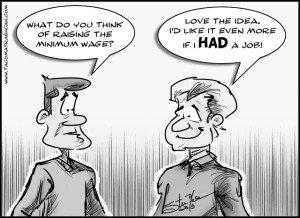Junior pay rates in modern awards: Are young people being ripped off?

A “fair go all around” has long been an underlying principle in the Australian industrial relations system. However, under many modern awards, employees aged between 15 and 20 years receive only a portion of the full adult wage despite often undertaking the same work as an adult. For those junior workers who do not fall under a modern award, the national minimum wage operates to a similar effect. This begs the question, are these young workers really getting a fair go all around?
Why are young people on a lower wage?
The justification for paying young people a lower rate for the same job is that it is actually for young people’s benefit. For instance, a lot of young people seeking work are generally inexperienced and unskilled. An employer thus needs a reason to employ them over someone who has experience and skills which are qualities that older workers often bring to the table. Therefore, lower wages for young people is said to encourage employers to employ young people, providing more entry level jobs for young people whilst compensating employers for the higher training costs associated with younger workers.
Should lower wages for young people be abolished?
If the youth wage were to be abolished, then the rationale goes that employers would have no incentive to employ young, unskilled workers and as such, entry into the job market would become increasingly difficult and youth unemployment would sky-rocket. The 1999 Productivity Commission Report on the youth wage confirmed as much. That report found that a ‘1% increase in youth wages would result in a decrease in youth employment from about 2-5%’. The findings of this report have consistently been touted in support of indexed youth wages.
How are adults with no experience treated under modern awards?
The justification for paying young people junior rates regardless of their skills and experience starts to unravel with a few examples. For instance, a 19-year old might have worked as a kitchen hand for 3 years but will receive 85% of the adult rate under the General Retail Industry Award 2010. In contrast, a 26-year old who has no experience working as a kitchen hand will receive the full adult wage.
Similarly, an 18-year old starting their first job at a fast food restaurant as a casual will receive $20.08/hour which is 80% of the adult wage under the Fast Food Industry Award 2010. However, a 23-year old also with no experience will receive the full adult wage of $25.10/hour. Although the 18-year old and 23-year old both have no experience, the 23-year old is still paid the adult wage.
Indeed, the Fair Work Commission (FWC) has somewhat recognised the inequality generated by the junior rates. In March 2014, the FWC decided to increase the Award wage for 20-year old employees that were covered by the General Retail Award. The ruling ensured that 20-year old employees were now paid the same rate as adults provided they had worked with the company for 6 months.
So, what is the solution?
If the whole point of junior rates is to incentivise employers to employ inexperienced and unskilled workers, then the solution may be to pay new and inexperienced workers a lower rate. For instance, in New Zealand, there is a “starting-out wage”. This is paid to 16 and 17 year old employees for the first six months of continuous employment with their current employer and is equal to 80% of the adult minimum wage.
At present, the system is not ideal and can result in unfairness to young people who are performing the same work as similarly experienced and skilled adults but are not receiving the same pay. I will be interested to see how this area of law develops in the coming years as the FWC strives to balance the notion of “a fair go all around” with facilitating entry into the job market for young, unskilled workers.




